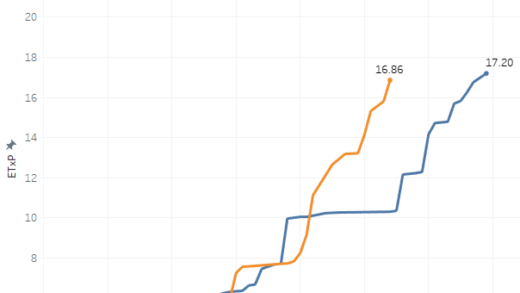As an expansion team there is usually little in the way of expectations, even for one coached by the legendary Wayne Bennett. Very few had the Dolphins anywhere near the top eight this season, and most predictions were for a bottom four finish.
And it looks like that’s exactly where they’ll finish up. And it’s possible they’ll have a better for and against margin than the Canberra Raiders.
They should have picked up another victory on the weekend with a win over the Titans, but Api Koroisau broke their hearts with a penalty goal in the 76th minute.
Still they had more than enough possession to win the game based on expected points.

Earlier in the season they were far ahead of almost any expectations, firing off three straight wins to start the season and then testing the Broncos in the first local derby.
But eventually the euphoria from their fairy tale start wore off and reality set it, this was a team that wasn’t likely to be playing in September. As mentioned above though, no one expected them to so it’s hard to consider this year anything but a success for the club.
But at what point did things start going pear shaped?
When rummaging through the numbers to check how their initial season had progressed, there was a pretty clear delineation at Round 13, for a number of reasons and with some stark results.
As I usually do with these team specific deep dives, I’m going to start by looking at their average margin by minute to see how well they club was competing over the course of a game. One thing we’ll have to differently here is how we look at average margin by minute, as we don’t have any prior Dolphins seasons to compare it to.
Instead, I’ve looked at two particular splits of their season. The first is checking their performance against top eight and bottom nine sides to see if there was any significant difference. As usual numbers are from Fox Sports Stats.
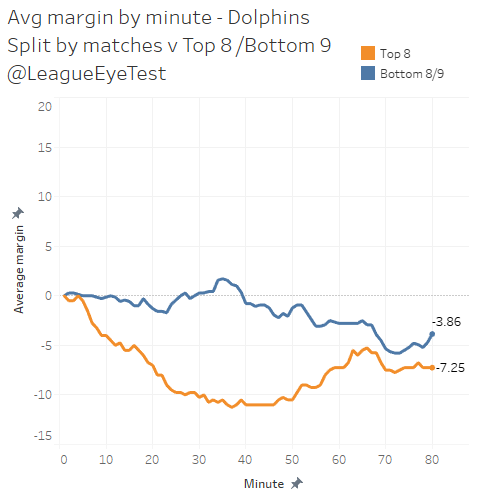
The Dolphins have a negative average margin after 80 minutes against both top eight (-7.25) and bottom 9 (-3.86) sides this season. The big difference is that they could keep pace with bottom nine sides for half a match and were still on average within three points after 67 minutes.
But against top eight sides the wheels fell off early and they found themselves down by an average of 10 points after just 29 minutes. They were able to claw some of that gap back in the second half of those matches, as you’d expect from a Bennett coached side.
This resulted in them spending the third highest percentage of minutes behind on the scoreboard in the NRL this season up to Round 25
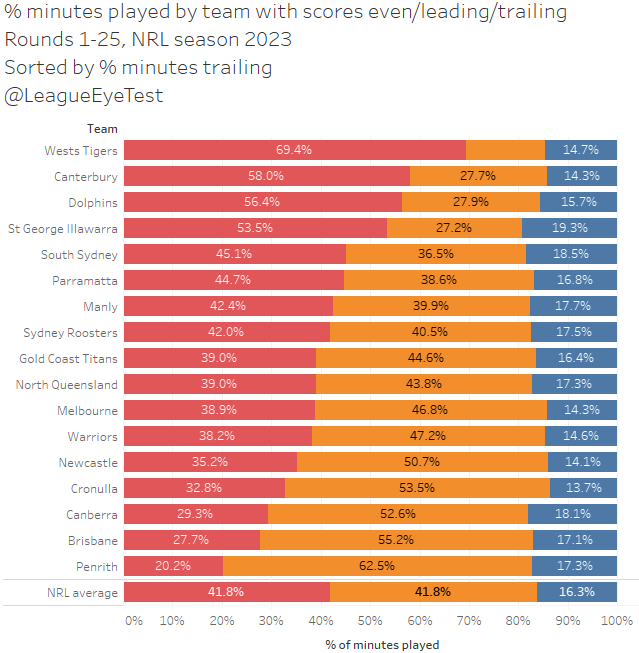
.
Over 56% of their minutes played were spent chasing points, with just 28% ahead on the scoreboard, only ahead of the Bulldogs and Tigers, hardly elite company.
Now if we look at the first half/second half split of the season, there’s a much more positive story for the Dolphins. After Round 13 they were sitting in 6th position with a +15 margin differential, and the blue line shows how from this chart how competitive they were for the full 80 minutes up to that time.
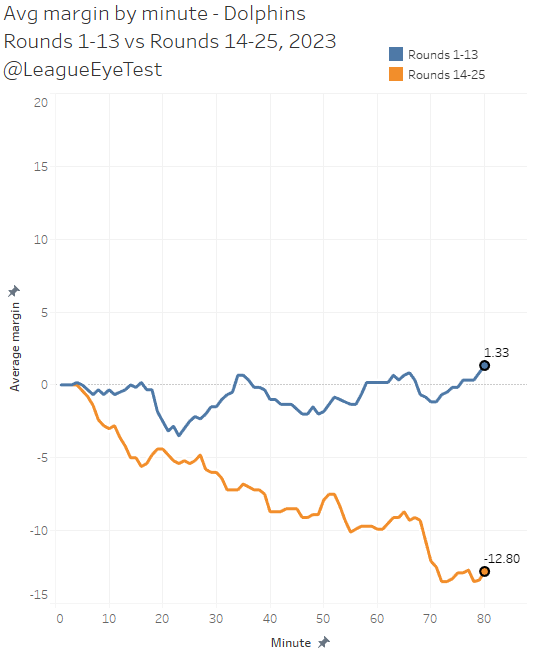
So why was Round 13 the point their season dropped off? Firstly it coincides with losing players to State of Origin. Secondly, it was the start of Jeremy Marshall-King missing time with the start of his shoulder issues. Their starting hooker played just two games for a total of 121 mintues between Round 14 and Round 21. During that time the club went 1-5, with their only win being a 23-21 golden point win over the Gold Coast, who in very un-Titans like fashion didn’t kick on with a 14-6 half time lead.
I wouldn’t want to pin their whole season on Marshall-King’s availability and how much the shoulder was bothering him, but they were 6-9 in games he took the field. And in games where he was available for the full 80 minutes, they were 6-7. That’s still a losing record but would have had them fighting for last spot in the top eight with Parramatta, Souths, North Queensland, and the Roosters.
It’s not particularly surprising that once Marshall-King’s availability became an issue along with representative duties for key players like Hamiso Tabuai-Fidow and Tom Gilbert, the team suffered. The depth wasn’t there, and they lacked experienced players at key positions to get them through that period. He was one of the early buys of the season and you’d have to wonder if the Bulldogs would like to redo their hooker swap this year.
Going back to the minutes trailing chart, if we split that by the same first half/second half of the season, the numbers were much better. They spent just 46% of the time trailing, and 37% of the time ahead on the scoreboard. Again, those would be numbers that place them in the group of teams competing for the top eight.
One of the bigger issues for the club in 2023 has been pushing the ball downfield. They’re 15h in the NRL for metres per run at just 8.61 per carry.
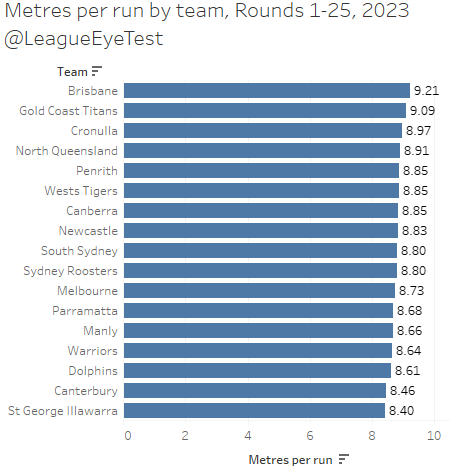
The only teams they’re ahead of are the Dragons and Bulldogs, both of whom average less than 8.5 metres per run. Their pre contact average of 5.87 puts them mid table, it’s the post contact metres at just 2.75m that places them in the bottom three. Given the composition of their aging forward pack, it’s not surprising that they lack significant punch to push through the defensive line.
Metres per carry is also an issue defensively. The Dolphins give up 9.16 metres per run, only the Titans at 9.17m concede more yardage to opponents.

And again, it’s mostly from post contact metres, where they join the Gold Coast as the only teams to allow more than 3 metres per run post contact.
This gives the Dolphins the worst net metres per run of any team in the competition for 2023.

They allow over a half a metre more per run than they gain themselves, dead last in the NRL. Even the Dogs only give up an extra 36cm. And they did so in both halves of the season. Improving this area of their game should be Bennett’s key focus for 2024.
Their inability to push through contact and generate yardage has meant that they’re spending far too much time in their own half. 59.5% of their play the balls to be exact.
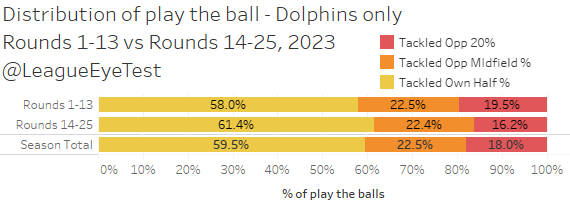
And as you can see by the split of Rounds 1-13 and 14-25, that number jumps up to 61.4% after Round 13, with just 22% in opponents midfield, and 16% in their opponents 20 metre zone.

That 61.4% is last in the NRL, and one of just three teams (along with Manly and Newcastle) to spend more than 60% of play the balls in their own half since Round 14. Another example of the Fins being an average side for the first half of the year and a very ordinary in the second half.
An interesting sub plot of why they can’t get downfield might be found in where their first tackle plays are starting. Below are the average metres from a teams’ own try line that their first play the ball occurred, sorted by second half average.
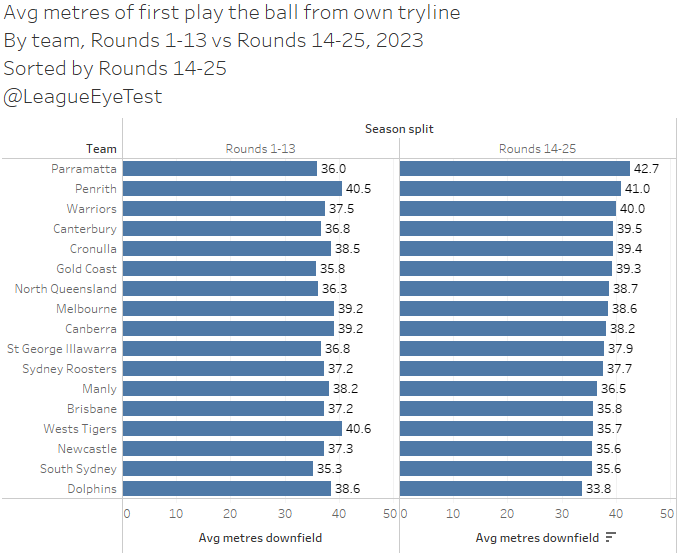
Here’s a great example of the woes of the Dolphins second half of the season. From Rounds 1-13, they had the fifth furthest first play the ball downfield of all 17 NRL teams at 38.6 metres. Yet from Rounds 14-25, their average starting position on first tackle is just 33.6 metres out, 17th in the NRL.
Why did this happen? From Rounds 1-13, Hamiso Tabuai-Fidow averaged nearly 6 kick returns per game. Post Round 13, that number plummeted to just 2.2. Jamayne Isaako’s returns went from 1.5 to 2.2 per game. Opponents have worked out how to get the Dolphins starting their sets closer to their own line.
If we visualise this to the average position for each play the ball, you can see where the gaps exist.

Their first play the ball in the first half of the season (Rounds 1-13) is not far from their second play the ball in the second half of the season (Rounds 14-25). By the fifth play the ball, they eventually end up about 1.5m behind the first half of the season but starting out on the back foot has clearly hindered them.
Another reason for their inability to gain metres might be how narrow they’re playing. Below is a heatmap of all play the balls this season for The Dolphins.
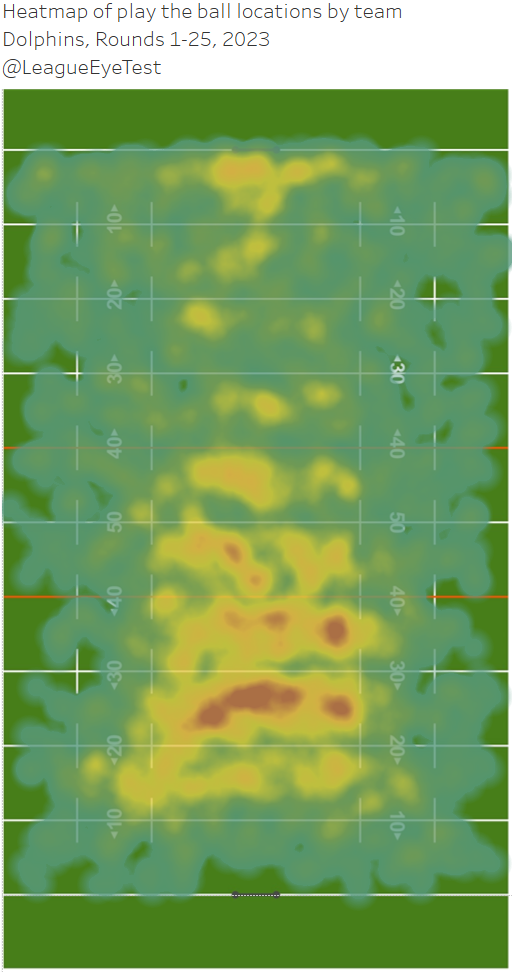
Most teams have at least some darker yellow intensity near the tramlines on the edges of the field, but the Dolphins is primarily the middle of the park, other than coming off their own line where it widens slightly. Indeed, they have one of the narrowest average play the ball widths from the centre of the field at just 10.9m either side of the middle. With some of his more experienced players missing, it’s not surprising that Bennett may have simplified their game plan.
Defensively they’re very lax with their pressure on early tackles. The Dolphins rank 16th, 16th and 15th for opponent metres conceded past the play the ball on tackles 2, 3 and 4 from Rounds 14-25. Yet on tackle 2 in the first half of the season (Rounds 1-13) they were 7th. Not wanting to harp on this point, but clearly the defense wasn’t up to scratch once Origin season started and things haven’t improved.
Field position isn’t everything though, it’s what you do with it that counts. And when you look at the Dolphins performances compared to this site’s expected points model (ETXP) you get a better understanding of their weaknesses post Round 13.
Comparing their actual on field scoring to their expected points, the Dolphins were pretty consistent in either half of the season.
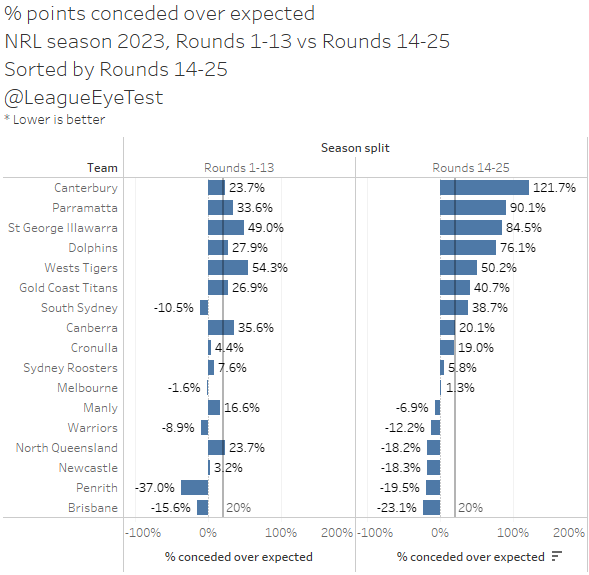
For both the first half and second halves of the seasons the Dolphins scored 23% more points than expected, higher than the NRL average at 19%. Not overly efficient, but not inefficient either. You could say they were mid.
But their biggest problem was conceding far more points than they should have post Round 13.

A staggering 76% more points than expected to be exact, up from just 28% in the first half of the year. That +76% has ranked them fourth worst in the NRL from Round 14 onwards, indicating that the Dolphins are conceding far too many points from positions on the field that don’t usually yield tries from.
For a team that has come together quickly and features a lot of inexperienced players, their ball security has been fantastic.

Their error rate of one every 42.6 touches places them 5th in the NRL, only behind Penrith, the Warriors, Melbourne and North Queensland.
Despite the bleak end to the season, there’s plenty of reasons for Fins to be Up in 2024. They were looking highly competitive for the first three months of the season and if they had stayed healthy it might have been a different story. They showed early in the season they could stay with most teams in the NRL, and it wasn’t until the injury bug and representative honours called that things went south.
It’s also incredibly hard for a team full of new faces who’ve never played together before to become a formidable, cohesive defensive unit. Especially when so many of them had not played significant NRL minutes at all, let alone together. Another full pre-season together gives them plenty of chances to fix this. Andrew Webster’s remarkable turnaround with the Warriors shows it can be done in a season if everyone buys in.
On an individual basis, the impact Bennett has had on a number of players this season has been remarkable. Isaako has gone from being unable to get a consistent spot on the Broncos OR Titans, to sharing the lead the NRL for tries and leading points scored. Tesi Niu was also maligned at the Broncos and has found a home on the wing with the Fins, where his defensive issues aren’t as apparent as they were in the #1 jersey. Connelly Lemuelu was another outcast, this time from the Cowboys but had firmly locked down an edge spot before missing time with concussion.
The future looks bright for them as well. Isaiya Katoa was thrust into a lead playmaker role at just 19 when Sean O’Sullivan was injured early in the season and looks like a tremendous building block for the club. Next season they’ll add some strike power with Herbie Farnworth, some backline versatility with Jake Averillo and also add some youth to their aging forward pack with Tom Flegler. This should hopefully address some of the depth issues seen this season, although Flegler is likely to pull on a maroon jersey again next year.
A few more high profile signings like Farnworth or Flegler will go a long way into securing their future. The fact they haven’t made one thus far, even with Bennett as a lure could be seen as a disappointment. But they shouldn’t be signing a name for the sake of signing a name. It has to make sense, and there’s no point sacrificing the long term future of the club for a short term splash with no exit strategy.
For expansion teams, growth is a marathon, not a sprint, and the Dolphins seem to be moving along the right path for now.


